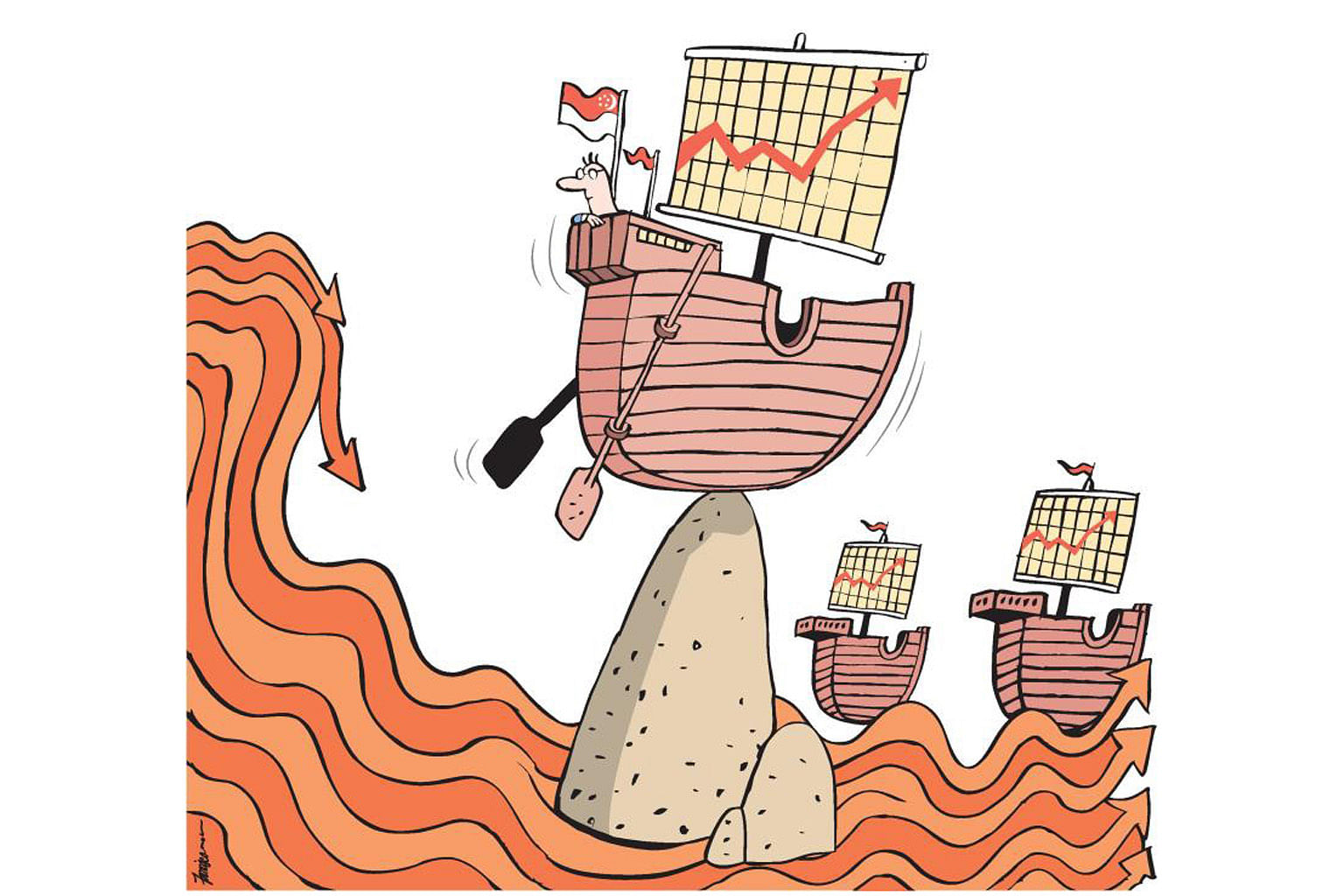The outlook for the global economy is gradually brightening and prospects for Singapore's growth are strengthening in tandem.
The Ministry of Trade and Industry said last week that 2017 economic growth is likely to come in above 2 per cent. That sits at the higher end of its 1 to 3 per cent forecast for the full year and surpasses last year's modest 2 per cent pace. This more cheery outlook follows years of mostly modest economic growth since 2009, when the global financial crisis was in full swing. The concern, however, is that growth is not picking up across the board.
Much of this stronger performance has been limited to trade-related sectors including electronics manufacturing and wholesale trade. Meanwhile, other sectors which rely largely on local demand, such as retail and food and beverage, remain mired in a slump.
Could stronger trade growth be a decisive sign that the economy is taking a turn for the better? Or will deeper structural issues get in the way of a broader recovery?
TRADE PICK-UP COULD FIZZLE OUT
The trade-dependent manufacturing sector did most of the heavy lifting in the first three months of this year, expanding 8 per cent year on year. This was the second-fastest pace of quarterly manufacturing growth in at least four years - following the 11 per cent surge in the preceding quarter. The pick-up came on the back of robust global demand for semiconductors and semiconductor manufacturing equipment, which boosted Singapore's electronics manufacturing and precision engineering clusters. Electronics makes up about one-third of total manufacturing output.
The transportation and storage sector also did well, growing 4.2 per cent in the quarter from the same period a year earlier as international trade picked up pace.

The uptick in global trade has been driven mainly by consumer demand from developed economies like the United States as well as China, says DBS senior economist Irvin Seah. However, the trade recovery has yet to spill over into other sectors to lift the economy as a whole and it remains to be seen whether it will last long enough for that to happen.
Even within the manufacturing sector - which makes up a fifth of the economy - performance has been patchy. For instance, transport engineering, which includes the marine and offshore segment, continues to face headwinds amid low oil prices.
"(Manufacturing) has been firing on a single engine. The strength of manufacturing output has been narrowly focused on electronics, particularly semiconductors which account for 17 per cent of total industrial production," says ANZ economist Ng Weiwen.
And what is more, the manufacturing rally could be coming to an end. DBS' Mr Seah notes: "Companies seem to be taking a wait-and-see approach. Consumer demand could ease off in the coming months...The manufacturing sector is expected to run sideways and might even moderate in the second half or towards the end of the year.
"Overall growth is likely also to mirror that trend," he adds.
There are also other threats to the global economic outlook, including political uncertainties over the outcome of Brexit talks and potentially tighter credit conditions in China.
DEEPER STRUCTURAL ISSUES
But the cyclical nature of the global economy is not the only reason behind Singapore's struggles with slowing growth over the past few years. Even if the turnaround in export-oriented industries does signal a revival of the global economy - setting aside the significant geopolitical risks looming on the horizon - other sectors are facing deeper structural issues that stronger growth alone cannot solve.
Disruptive change has hit almost every industry and has had a transformative impact on the labour market, with jobs evolving faster than ever and new roles emerging even as existing jobs fall into irrelevance. For instance, besides lacklustre consumer sentiment amid the slow economy, the retail industry has also been facing longer-term challenges such as the shift towards e-commerce.
"There is still that undercurrent of worry even as growth in developed economies gradually picks up - because of the impact of technological disruption," says CIMB Private Bank economist Song Seng Wun. "We're seeing uneven growth overlaid by the impact of technological change, which has created new opportunities but also constrained the recovery of existing industries."
Despite a more sanguine economic outlook, the labour market has remained fragile as a result of these shifts.
Preliminary labour market statistics released by the Manpower Ministry (MOM) in April showed the overall unemployment rate edged up to 2.3 per cent in the first quarter, rising to a level last seen in the fourth quarter of 2009 following the global financial crisis.
UOB economist Francis Tan points out that consumption expenditure shrank in the first quarter - the second straight quarter of decline. This was the first time in a non-recessionary period that consumption slid for two consecutive quarters.
"This could signal a deeper, structural issue within the labour market that weakened consumer sentiments and resulted in the contraction of household consumption," he notes.
The challenges some industries are facing go deeper than slow economic growth or poor sentiment. It will take more than stronger global growth to drive a turnaround in the job market, where retrenchments have risen on the back of disruptive technologies and a mismatch between the skills workers have and the ones that employers want.
While sectors like oil and gas have shed jobs, for instance, the IT industry is still short of local talent in emerging segments like cyber security and data analytics, but those retrenched may not find it easy to make the switch across sectors. The MOM has said that labour market performance will remain modest this year as businesses continue to restructure and some sectors grapple with cyclical weaknesses.
Ultimately, disruption is a fundamental issue that will shape Singapore's economy in the coming decade - a fact the Committee on the Future Economy recognised in its report issued earlier this year. Industry transformation, scaling up local enterprises and helping them go global as well as reskilling workers are vital to help the country prepare for an increasingly uncertain and volatile future, the report said.
CIMB Private Bank's Mr Song says it remains to be seen how these trends will play out. "Technology plays an increasingly important role and has a growing influence on businesses...How they deal (with it) and cope will be critical going forward."
These are fundamental shifts that will take time and will likely involve some difficult changes, especially for small and medium-sized enterprises here, as well as for workers. That means it would probably be overly optimistic to pin hopes for a sustainable rate of stronger economic growth solely on the back of the resurgent electronics manufacturing cluster.
The tide of recovering global demand could eventually lift more boats and the recovery might broaden to other sectors of the economy. But that will merely give Singapore some breathing room to deal with deeper, longer-term challenges that will shape the country's economy beyond the next global boom or bust.


